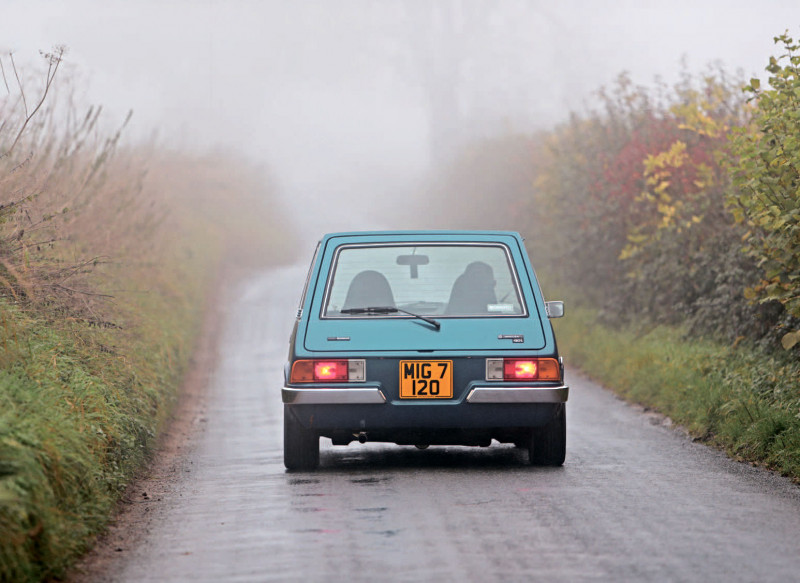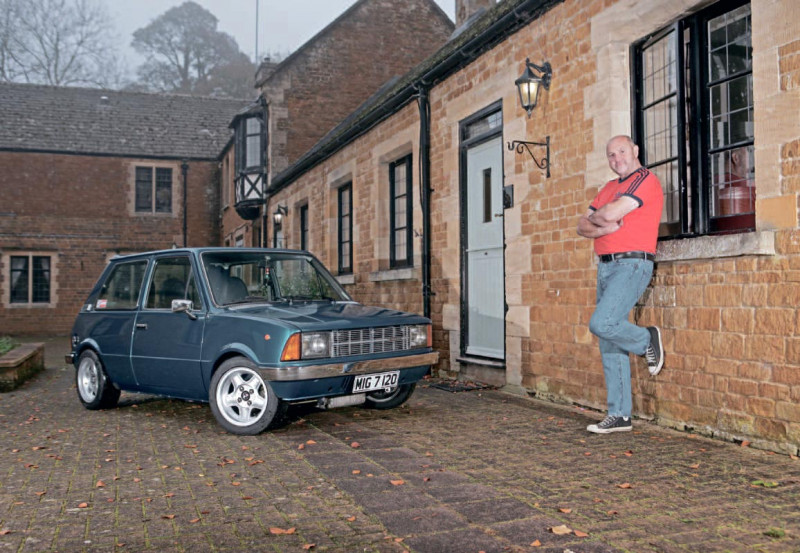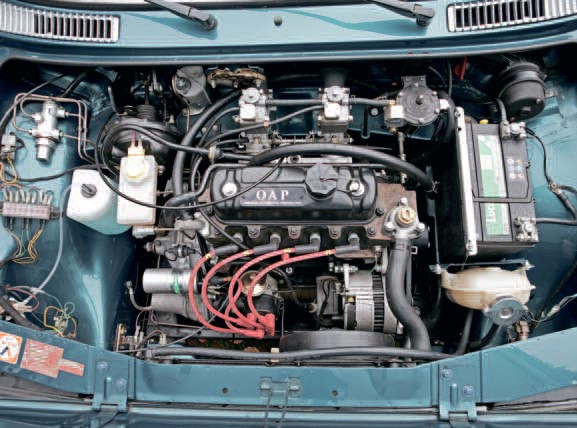Restored: 1979 Innocenti Mini
British buyers couldn’t buy a hatchback Mini, but those in Europe could – albeit not the Mini that we were used to. Words and pictures: Richard Dredge.
Restored: 1979 Innocenti Mini -Italian Job
INNOCENTI MINI: epic restoration of italy’s forgotten hatch
There’s no shortage of people who reckon Alec Issigonis missed a trick by not making the Mini a hatchback. A few cars were independently (and expensively) converted in period, but BMC/BL/AR never offered a factory-built three-door Mini. Well, at least not in the UK. However, over in Italy, that’s exactly what Innocenti was doing, with a completely repackaged Mini that shared its mechanicals with the Issigonis wonder, but it featured all-new Bertone-penned bodywork, as explained in the potted history of Innocenti on this page.

Although the Innocenti Mini was never sold in the UK officially, a handful of examples do exist here, although most of them are De Tomaso editions and hardly any are on the road. All of which makes Ian (Oz) Osborne’s recently restored 120 even more special. He comments: “The car was built in 1979 and imported to the UK three years later, and that’s when it was converted to right-hand drive. It wasn’t done especially well, despite the fact that it shouldn’t have been a difficult job at all. Innocenti explored the possibility of bringing the 90 and 120 to the UK when the car was being developed, and as a result the holes are already in the right places in the bulkhead for UK-spec cars to be made. Also the dashboard is symmetrical, so you don’t have to cut everything about to make it fit.” Oz is an avid collector of classic scooters and one of his best friends is Nick, who ran a scooter shop. Way back in 1986 Nick acquired the Innocenti and ran it for three years until it fell apart, at which point it was put into storage in a council-owned lock-up. Then, 27 years later, having paid around £50 per month to stop his Innocenti from dissolving, Nick worked out what he’d spent on storing the Mini and promptly flogged it to Oz. To save you reaching for your abacus, it’s £600 per year multiplied by 27 years, or more than £16,000 at current prices. Ouch. Even worse, the Mini had pretty much dissolved all the same.

Oz adds: “Nick asked me if I wanted to buy the Mini but I couldn’t afford it, although I did want it. The car was in such a parlous state and he had nowhere to keep it, that realistically he was going to have to give it away, so that’s what he did. I took it on, on the basis that I would rebuild it. And it needed a lot of work; when the car was on the road it had clearly needed plenty of regular welding to get it through the MoT each year. Nick had bought a replacement tailgate and door, and I gave him some money for those, but there was a huge amount of other panelwork needed, to get the car back on the road.”
Oz’s background is doing spannering under various guises, specialising mainly in rebuilding A-series and Porsche flat-six engines; you can find out more about Oz’s endeavours at facebook.com/ozoap. Having acquired the Innocenti in 2016, Oz put it in his garden with a view to restoring it when he had a bit more time. The problem was that its condition continued to deteriorate so he put a cover over it, but that made no difference, with the Innocenti continuing to succumb to the elements. From time to time Oz would find a part that he needed and it would be added to the pile, but no real progress was being made.

The turning point came in 2019 during a visit to Race Retro, where a driver’s wing was spotted. Oz snapped it up then realised that he really needed to get stuck into sourcing parts, or the Mini would continue to dissolve to the point where there would be nothing left to save. Rather than launch into the restoration and try to find parts as he went along, Oz opted to track down everything that he needed, so that he could get stuck in and not have to keep stopping to find another batch of bits. Throwing himself into the task in earnest, Oz found a fellow Innocenti owner in Wales, who was undertaking his own Mini restoration. Having sourced two complete sides he then realised the task was just too much, so he sold the fresh panels to Oz, before selling on the project separately – making the life of its new owner significantly harder… Oz comments: “The big parts were fairly easy to track down; it was the small things that were much harder to find. For a while I devoted my life to scouring the Italian, German and French eBay websites, and it was through these that I found a driver’s door in Spain. The rear panel took some finding, but eventually I tracked one down in Germany, along with a fuel tank.

“One of the most useful contacts was a guy called Theo, who is based in Athens. He was an absolute godsend because he had so many bits that were unavailable elsewhere. He sold me a front panel and a bonnet along with all sorts of other stuff. He specialises in new old stock for British classics and he asked me to send him a list of what I needed. I ended up buying just about everything he had.”
The common thread that runs through most of our restoration stories is the importance of the internet, and specifically the Facebook groups that proliferate. That was certainly the case for Oz, who tracked down a fellow fan in Belgium who used to break Innocenti Minis. Oz picks up the story: “My windscreen was damaged, so I posted a question in a facebook group and I was pointed in the direction of this Belgian chap. He’s sitting on a stack of new and used parts for these cars and he’s currently restoring two of them himself. He invited me to have a ferret in his garage so I did just that, and I came away with all sorts of stuff that is pretty much extinct now: the unique 120 gearknob, lots of trim clips, three windscreens and even some badges.”
By May 2020 the UK was in lockdown and Oz had collated everything that he needed to get his Innocenti rebuilt. Spurred on by his daughter Sophie reminding him at regular intervals that he needed to pull his finger out and get the job done, Oz booked the bodywork in with his friend’s bodyshop, so that all of the panel and paintwork could be sorted while he focused on getting the mechanicals overhauled. By Easter 2021 the fresh panels had been stitched together to create pretty much a new bodyshell, which was all finished in a beautifully applied coat of original metallic blue paint. While all of that was being done, Oz was cracking on with building up the subframes, overhauling the A-series engine, rebuilding the gearbox and putting together the wiring loom. It was this latter area that caused the biggest headaches because although Oz had two wiring diagrams, one in German and the other in Italian, neither seemed to relate exactly to his car. But by working through everything methodically, Oz was able to get everything working as it should. Predictably, when it came to rebuilding the engine, Oz pulled out all the stops. He comments: “I’m known for my rev-happy engines, with everything lightened and balanced, and as a result the safe limit for my 120’s engine is 7500rpm, compared with the 5500rpm in standard form. The standard 120 was fitted with a single SU carb, but I wanted to switch to a pair of Italian carbs. I opted for Dell’Orto FZDs and I found a pair in Belgium along with another in Portugal. One was a set of 30.24s and the other were 32.28s, so I tried them both to see what the results were. After setting everything up and putting the car on a dyno the smaller carbs produced the same peak power (94bhp), while torque for both also peaked at 88lb ft, but it got to 80lb ft 800rpm lower in the rev range with the smaller carbs. So it was the 30.24s that I stuck with.”
With the entire car having been rebuilt before the bodyshell was painted, Oz had a four-week window of opportunity to trial fit everything. It’s just as well that he did. There were all sorts of things that didn’t quite fit properly, so lots of tweaking was required to get the right clearances and shut lines. The bodyshell then went into the paint booth before being returned to Oz for an intensive seven-week fitting-up period. Oz continues: “The Mini came with a complete interior, but some of it was in a poor state. The front seats were beyond saving with their broken frames and rotten cloth, so I fitted MX-5 items instead. I’ve been able to retain the rear seats although they’re a bit tatty, but the door cards and parcel shelf are better. I’m on the look out for some better trim, but I doubt I’ll find any. “The dashboard is the factory-fitted item, but with everything swapped over to make it right-hand drive. This has caused a problem in that the speedometer doesn’t work because it needs a cable and I can’t find one that fits. I use a sat-nav unit to tell me my speed and the lack of a working speedo didn’t cause any problems with the MoT, which it went through last summer, without a hitch, and since then the car has done more than 6000 trouble-free miles.
“Now that the car is finished I’m really enjoying driving it as much as I can. It’s four inches wider than a Mini so it handles superbly, things helped with the fitment of Koni dampers, which is my go-to brand. The MX-5 seats are comfy and supportive, the car is quick and it looks fabulous from every angle, especially with the Revolution RFX alloy wheels that I had in stock. The original plan was to get the car finished in time to take it to the International Mini Meet in Florence in May 2021, but Covid knocked the event back to 2023, with this year’s IMM taking place in Germany instead. I’ll be racking up plenty of miles in 2022, but I can’t wait to take the car back to its homeland next year.”
How it was done
- 1. The Mini emerges from its garage for the first time in 27 years. Oz’s mate was so excited about the project that he drove from Morecambe to Aldershot to trailer the car home to Sussex for him.
- 2. It would be another four years before the car was stripped to a bare shell, which showed just how rusty it was. Or so Oz thought...
- 3. Once the sides of the car had been removed, the full horror became all too apparent. The car was much worse than expected, but he’d assembled all of the parts by now, so he pressed on.
- 4. Four years of searching on eBay turned up a complete set of outer panels. The only panels not replaced during the rebuild were the roof, the bulkhead and some of the floor.
- 5. With the bodywork largely done, Oz had the car back for a month to trial fit everything. The front end was all fine, but some of the rear panelwork had to be fettled to allow the fuel tank and subframe to fit properly.
- 6. Oz spent a few days over Christmas helping out with flatting down the paint and getting everything ready for the top coat to be applied.
He also helped to sort out the shut lines for the tailgate, bonnet and doors. 7. While the bodywork was being done, Oz focused on getting the running gear ready. This included the original front subframe which was blasted, zinc primered then powder-coated in satin black, before everything was fitted to it. 8. Oz took 140 hours over seven weeks, to fit all of the chrome, electrics and mechanicals ready for the MoT, which was passed first time.
Innocenti potted history
Innocenti Societa Generale per l’Industria Metallurgica e Meccanica SpA, better known as Innocenti, was founded by Ferdinand Innocenti in 1933; the company would go on to make its name with Lambretta scooters. In 1960 Innocenti branched out into car manufacturing when it took out a licence to build the Austin A40 in its factory near Milan. Then in 1965, six years after the introduction of the Mini, it entered into an agreement to build that car under licence, production continuing until 1976, with more than 436,000 of them built in an 11-year production run. Ferdinand Innocenti died in 1966. Six years later, his company was sold to British Leyland, which renamed it Leyland Innocenti SpA. By the summer of 1975, the company had gone bust and, within a year, it would be sold to Alessandro de Tomaso who formed Nuova Innocenti SpA.
In that brief period of BL’s ownership of Innocenti, it put its own version of the Allegro into production (theRegent, tested). It also produced a completely rebodied version of the Mini, which sold alongside the regular Mini. Known as the Mini 90 or 120 (depending on engine), and available from late 1974, this supermini was offered in an array of markets within mainland Europe, but never the UK. Innocenti commissioned Bertone to come up with a completely new bodyshell which would feature a hatchback for added practicality. All of the running gear would be carried over from the Mini, with two versions available. Those who favoured economy could opt for the Mini 90 with a 48bhp 998cc A-series engine, while the Mini 120 featured a 1275cc unit that produced 64bhp.
There was nothing inside or out that gave away the Mini’s origins, because none of the bodywork was carried over, and the interior was also completely new. However, beneath that boxy skin was a Mini front subframe (the rear one was redesigned to accommodate a bigger fuel tank), Mini steering, brakes and rubber cone suspension, plus the usual four-speed gearbox.
Predictably, because it was more than a decade newer, the Bertone-designed Innocenti Mini was much more grown up than the Issigonis original. It looked far more modern and there was a healthy dose of added versatility thanks to the fold-down back seat. There was also more cabin space, due in part to a marginally longer wheelbase, a 66mm increase in length, while the car was also 89mm wider.
Once Leyland Innocenti had gone bust and the company had moved into de Tomaso’s hands, he introduced a sportier model with a 71bhp (later 74bhp) 1275cc A-series engine. In 1978 the Commerciale van came along, then in 1980 came the final edition, the 998cc Mille. With its glassfibre bumpers and a refreshed interior, in its own small way it ushered in a new era for the Innocenti Mini.
By spring 1982, with more than 232,000 examples made, the Innocenti Mini was no more because it gave way to the Minitre, with a threecylinder Daihatsu engine. From here on the Mini platform was retained, but that car’s suspension was ditched in favour of MacPherson struts up front, with independent rear suspension by lower wishbones and a transverse leaf spring. A Daihatsu diesel engine was introduced in 1984, then a long-wheelbase model came in 1986 (stretched by 160mm and known as the 990). The fruitiest and most collectible model of all however, was the de Tomaso Turbo which made its debut in 1983. Fitted with a 71bhp turbocharged 993cc three-cylinder petrol engine the car was a riot to drive, although it suffered from a profusion of shortcomings in the comfort department.
In 1990, Fiat bought the rights to Minitre production, but by now it was on borrowed time. Production limped on until 1993, with the final cars sold as the Innocenti Small and fitted with 659cc or 993cc three-cylinder petrol engines. Total production figures aren’t known across the multitude of iterations, but few Innocenti Minis survive because they began to rust catastrophically as soon as they left the factory.


